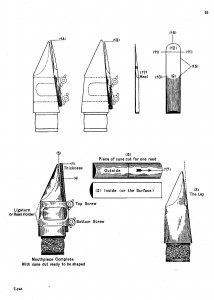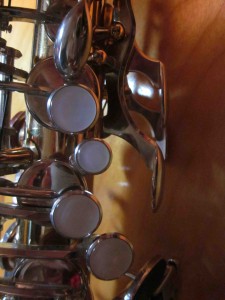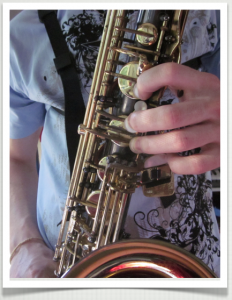Pretty sweet.
King Curtis is sounding good, Chuck Rainey too. Chuck Rainey is an awesome person that I met a little while back through Victor Wooten. He’s got some stories!
They’re playing at the Shea Stadium in 1965, opening act for The Beatles.
Pretty sweet.
King Curtis is sounding good, Chuck Rainey too. Chuck Rainey is an awesome person that I met a little while back through Victor Wooten. He’s got some stories!
They’re playing at the Shea Stadium in 1965, opening act for The Beatles.
By Neal 3 Comments
Having control over the full range of the notes of your saxophone is important.
Not comfortably knowing all of the major scales, for example, will very much limit your saxophone playing.
But having good rhythm and knowing only one major scale is better than having bad rhythm and knowing all the scales.
BB King sounded pretty damn good with the limited number of keys he could play early on. And eventually he focused on that dimension of his playing too.
However, if you’re offbeat, it’s extremely noticeable. Things just won’t feel right, won’t line up right. It won’t groove.
It’s much easier to play around if you play a note that sounds a little off. You can just go up or down a half step. And you might come up with some colorful sounds.
Having bad rhythm doesn’t make your saxophone solo sound ‘colorful’, it makes it sound bad.
So definitely learn your scales, but also learn how to apply them using the other dimensions of music.
Art with color, but no form or any sort of structure can look cool, but for me, it’s lacking a lot.
And learning scales alone isn’t very much fun. You should also learn music at the same time and learn how to apply the scales to the music, especially with improvisation.
Which do you think is more important, having good rhythm or good note choices?
A little bit of saxophone humor with Smigly!
Some great music there in the background courtesy of Gordon Goodwin’s Big Phat Band. Their new album is That’s How We Roll
Got an email from Allen Mezquida with this message,
“Hi Neal. GREAT stuff on Saxstation. I thought you might dig this
animation about a sax player trying to make it online.”
And indeed I did, hope you like it too.
By Neal 9 Comments
The song is ‘Take Me Out to the Ball Game’. Another exercise in ear training for saxophone.
The first note for tenor sax and soprano sax is C and it’s G for alto sax and bari sax.
That first interval is an octave, like the first interval in Somewhere Over the Rainbow.
Just the first phrase here.
Might start doing some lessons in more interesting keys…..
Leave me any questions, comments, or suggestions!
 Got a question from Joe earlier about his setup and what might get him more volume on his sax as well as getting rid of the squeals and squawks.
Got a question from Joe earlier about his setup and what might get him more volume on his sax as well as getting rid of the squeals and squawks.
At first he thought a different ligature might help, but it didn’t.
He also really likes the sound of the mouthpiece he’s using now…..
He said he was using a Selmer C* mouthpiece, which I know doesn’t have a wide tip opening and can get a great sound. But is generally better in a classical setting. I thought I might know of a solution to help him get more volume on his sax……
The C* mouthpiece (referring to the tip opening), is more designed with classical music in mind. Not to get a lot of volume, like you might want in jazz, funk, R&B, etc.
Therefore using a harder reed might compensate for the narrow tip opening.
A general rule is that you want a softer reed with a wider tip opening and harder reed with a narrower tip opening. Let me know if the harder reed makes things better.
Joe’s response:
“hey thanks for that the harder reed solved the squawking and the volume problem. ( i had some extra vandorn 3 1/2 ‘s left….”
There was another issue he’s still having with his sound, but the volume part was solved.
You want to get a balance between the reed strength and the tip opening of your mouthpiece.
By Neal 17 Comments
Lisa Simpson played the bari sax. And there was a bit of saxophone on the show for a while. Back when Bleeding Gums Murphy still lived.
Here’s a lesson teaching you that riff. It starts on concert Bb as I’m playing it here, not the original key. But it’s an easy key to play on saxophone. It will be good for you to be able to play it in multiple keys.
The point of learning musical ideas is to bring them into what you can play and you don’t want to be restricted by the key!
Let me know how it goes and if you have any suggestions for the format.
By Neal 3 Comments
Double tenor saxophones on stage!
They’re playing Herbie Hancock’s song ‘Watermelon Man’ at the Montreux Jazz Festival (Switzerland).
Kirk Whalum and Boney James on tenor.
Rick Braun and George Duke are also up there.
 Saw a question on Cafe Saxophone about a sax player seeing music with a play along book. The music for alto sax was in a bit of an awkward key and the music for tenor/soprano sax felt more natural.
Saw a question on Cafe Saxophone about a sax player seeing music with a play along book. The music for alto sax was in a bit of an awkward key and the music for tenor/soprano sax felt more natural.
Sometimes that’s how it goes. Might have been written by someone who played tenor or just by a composer that had tenor sax in mind. Or that might just be how it happens to go. Classical composers attributed different feelings to different keys. And there’s probably some truth to that.
And while a particular song might be harder for alto sax to play in the original key, the opposite can also be true, it may feel better for the Eb instrument version. The Charlie Parker Omnibook certainly makes more sense on alto saxophone. Bird played it on alto in the first place after all. It even goes out of range (on the low end) for the Bb version so you need to jump octaves at times.
You probably want to learn it in the original key so you can play it with the backing track and with other musicians who will tend to play music in the original key.
But knowing music in multiple keys gives you freedom to play the ideas across many keys with singers and just pieces of it in solos.
By Neal 4 Comments
 Not all notes on saxophone are created equal.
Not all notes on saxophone are created equal.
Maybe they should be and maybe you want them to be.
But that’s going to take some work and control.
“My least favorite [notes] are c and c sharp. They just sound yuk. ugly….. Why do those notes not sound nice?”
-Wendy
Overall, the saxophone was designed pretty well to play in tune. The intonation needs adjustment from the player which you learn over time, but as a whole it’s not a task of colossal proportions to get the whole range of the saxophone in tune.
The tone of the notes however, is a bit more of a challenge to keep the same across the range of the saxophone.
The notes C and C# are actually notes that are pretty hard to make sound as good relative to some other notes saxophone. It’s a lot easier to make a note like G come out sounding good for some reason. Something to do with the acoustics of the saxophone. For a ‘C’ almost all of the tone holes are open and the sound can come out of any of them. For a ‘C#’ you’re not holding down any tone holes.
We learn the note C pretty early on, might have even been your first note. After all, ‘middle C’ is the middle of the piano.
But it’s definitely easier to make other notes sound good.
The first note young saxophone players learn should probably be a G, in my opinion.
What do you think?
By Neal 2 Comments
 Received a question from Tim about saxophone overtones that seemed to be coming out unintentionally. He was working on altissimo. My first thought was that it might be leaks, but he has a pretty new horn. Might also be an issue of the timing of lifting the fingers between the notes.
Received a question from Tim about saxophone overtones that seemed to be coming out unintentionally. He was working on altissimo. My first thought was that it might be leaks, but he has a pretty new horn. Might also be an issue of the timing of lifting the fingers between the notes.
Hi Neal
I hope you are doing well.
My question is about overtones. I have been working on some altissimo notes, and I guess in the process overtones. My problem is I hit ovetones in my normal playing. Just going from low F to low A.
It really sounds very bad when you hit a high A instead of a low A!
Don’t get me wrong I like have the use of overtones, but I want to be able to control them.
Is there something I can work to get some control with overtones?
Thanks for your help!
Keep rocking!
Tim
Neal: I’m doing well, thanks. I know you have a pretty new horn…. but it sounds like there might be leaks. They would cause the higher overtones to come out when you’re not trying to play them. Playing long tones in general will help you control your saxophone including when overtones come out. Also, is your setup comfortable? I’m talking about the reed/mouthpiece combo.
-Neal
Tim: I’m having the horn checked out in a couple of weeks and I’m going to try some different reed combo’s to see how that goes.
Thanks for the info, I’ll let you know how it goes.
Sonny Rollins on tenor saxophone playing ‘My One and Only Love’. Great ballad. I actually played this one at my friend Sergio’s wedding.
Good bit of it is done on solo saxophone too. You’ll hear some pieces of other songs in there.
Played in Montreal, 1982.


Want to play saxophone, but feeling lost and not sure how to get started?
In this online/downloadable class you will see methodical lessons in a sequence and you can get feedback and ask questions at any point.
Learn more
Want to take your playing to the next level?
You’ll learn fundamental saxophone skills, building past the basics. Master rhythms. Learn about phrasing, tone, and more. Here you will get feedback which is crucial to developing good habits.
Learn more